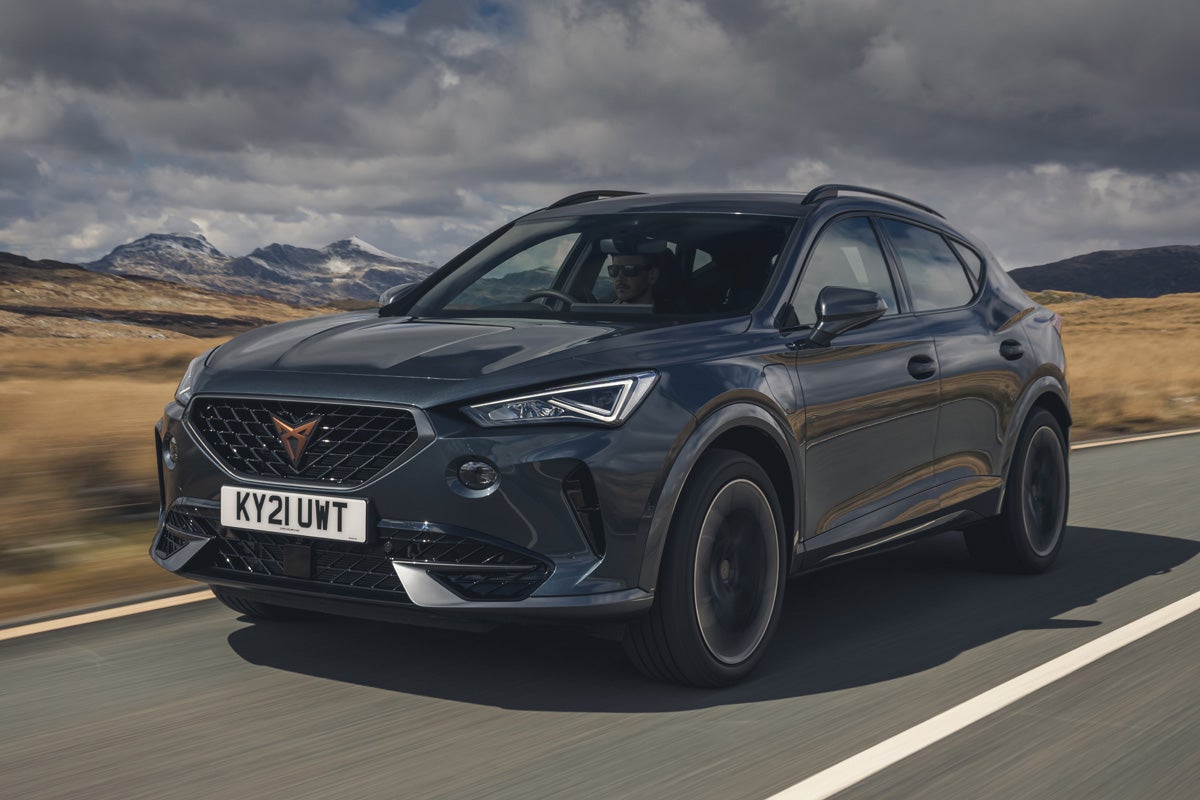Cupra Formentor Review 2025: Price, specs & boot space
Written by Andrew Brady
Quick overview
Pros
- Smart looking
- Well equipped and spacious
- Nice to drive
Cons
- Fiddly infotainment
- A hot hatch is more fun
- You pay premium car tax on high-end models
Verdict: Is the Cupra Formentor a good car?
"A few years back, Cupra untangled itself from the SEAT brand to become a marque in its own right, and the Cupra Formentor was its first solo attempt. The good news is that that it was - and continues to be - a mightily impressive small SUV."
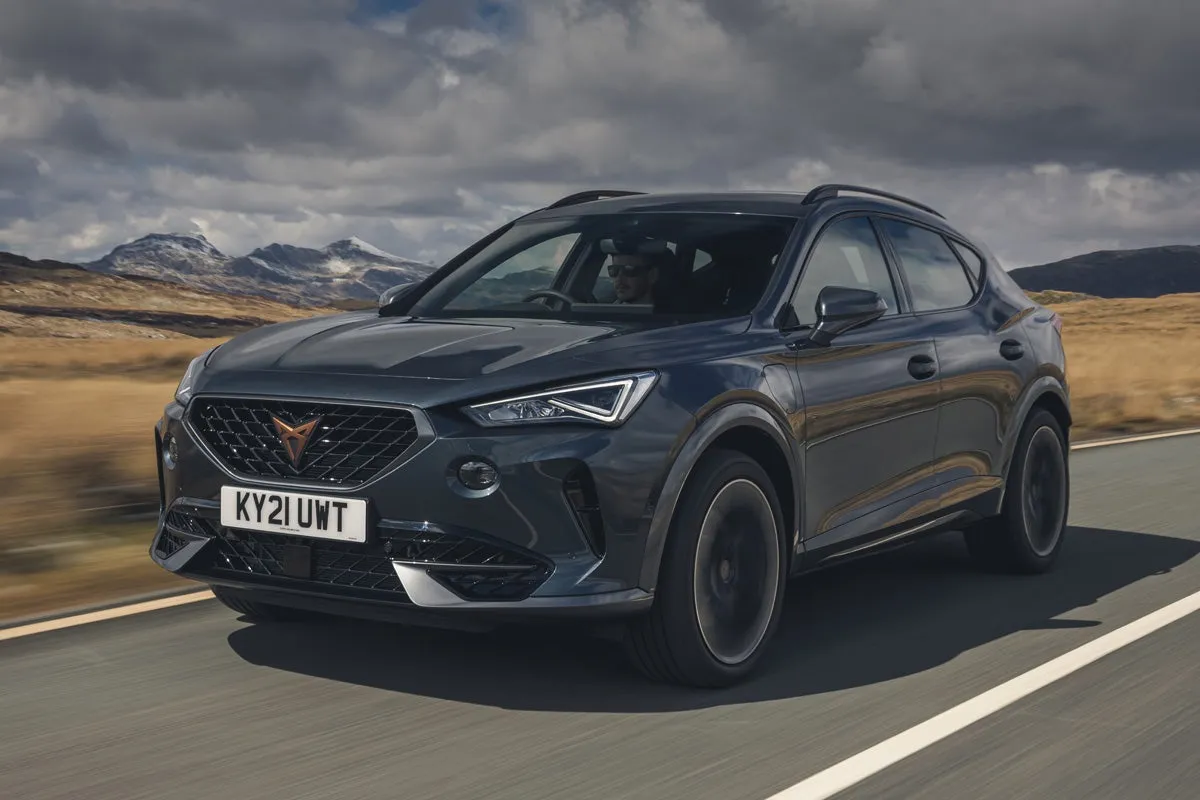
The Cupra Formentor may seem like a rather niche small SUV, but it's designed to appeal to the masses. It has an fashionable SUV body, big wheels, a tidy body kit and a sporty drive, all factors that have made the likes of Audi's S line and BMW's M Sport the most popular versions in their respective lineups. It's a car that can appeal to your heart, then, but how does it fare when your head chimes in with its opinion? As you'll discover in our 2025 Cupra Formentor review, the answer is pretty well.
Loosening its SEAT shackles has allowed Cupra to be more creative with design, but it still has the sturdiness and civility you'd expect of a VW Group product. Interior quality is on the whole good and the cabin has space for four people. The back seats fold neatly into the floor if you need to a carry a bike, and there are loads of smaller storage spaces to help keep the place tidy.
Alright, so the infotainment isn't quite so well thought out. The screens are large and colourful, but the car's too reliant on them: even the temperature, volume and lights are operated via fiddly touchpads. Apple CarPlay and Android Auto are fitted as standard, however, so if you've got a smartphone, it's worth plugging it in to use those more intuitive systems.
More good news comes in the form of the Cupra's excellent range of engines. The 1.5-litre 150PS petrol is all things to all people, cheap to run but also pretty brisk when you need it to be. At the other end of the scale, you'll find the hot 310PS 2.0-litre petrol – boosted to 333PS in more recent cars – and there are two petrol-electric hybrids sandwiched between the two.
Most of the range gets a slick-shifting seven-speed automatic gearbox and front-wheel drive, striking a good balance between being comfortable but also well-controlled in corners. The most powerful model adds serious performance and unbreakable four-wheel-drive traction to the mix, while the hybrids come into their own if you do lots of short journeys interspersed with the occasional longer trip.
Looking for a used car for sale? We've got 100s of Cupra Approved Used Cars for Sale, for you to choose from, including a wide range of Cupra Formentor cars for sale.
Is the Cupra Formentor right for you?
The Cupra Formentor is right for you if you want a relatively compact car that is cool, but has more space inside than a small family hatchback. It's nice to drive and comfortable, and has a broad range of engines that'll suit most people's performance needs and budgets.
What’s the best Cupra Formentor model/engine to choose?
The entry-level 150PS petrol engine will suit most people. It's not searingly rapid, but it never feels slow and the engine is refined and very economical. You get lots of kit as standard with the Cupra Formentor, but we'd take one step up from basic V1 trim to get a V2 model.
They look smarter thanks to their 19-inch wheels and feel posher inside due to their Nappa leather interior. The seats are electrically adjustable and heated, and you get a heated steering wheel, park assist and a very handy reversing camera.
What other cars are similar to the Cupra Formentor?
The Cupra Formentor is a stylish and sporty SUV, so you might consider it against models such as the BMW X2 and Audi Q3 Sportback. The Cupra isn't quite as sporty to drive as the BMW, but it's cheaper and has more back-seat space. It's also more comfortable than the hard-riding German car. The Audi, meanwhile, trumps the Cupra for badge appeal and has a posher interior, but it's not as nice to drive and is expensive.
Comfort and design: Cupra Formentor interior
"The Cupra Formentor feels sportier inside than your average VW Group product. You get touches like bronze stitching on the dashboard, doors and steering wheel."
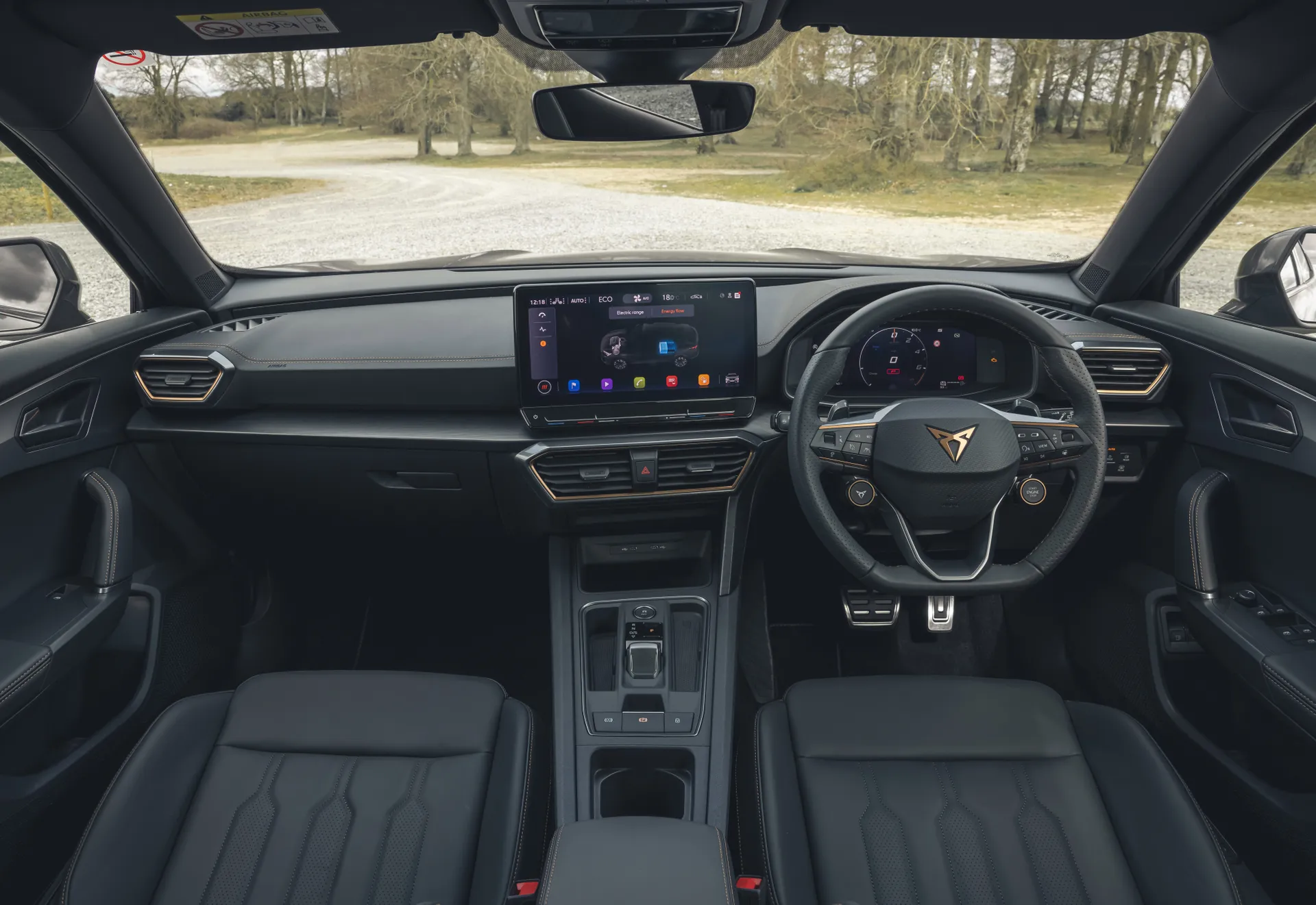
There's also carbon fibre look plastic that's more appealing than it sounds, and all cars have coloured ambient interior lighting and LEDs that shine a modern pure white light.
Basic Cupra Formentor V1 and VZ1 cars get PVC upholstery that looks (but definitely doesn't feel) like leather or Dynamic synthetic suede, while the rest of the range has real Nappa leather upholstery – which is used on the seats as well as the doors and dashboard – and you also get electrically adjustable seats.
Quality and finish
Cupra has attempted to forge its own unique identity on the Formentor's interior, but this is still very much a VW Group car, so it's sturdily built if somewhat bland. The dashboard and insides of the doors are made of soft-to-the-touch plastics, but the lower part of the centre console feels cheaper and you get harder plastics in the back of the car.
A facelift to the car in mid-2024 improved matters a bit, but one or two of the interior surfaces lower down in the cabin aren't quite as touchy-feely as those higher up.
Infotainment: Touchscreen, USB, nav and stereo in the Cupra Formentor
Much has been said about the VW Group's latest family of infotainment screens (a lot of it not positive), so while the 12.0-inch screen (12.3-inches on post-facelift cars) is colourful and clever – it understands smartphone gestures, for example – it can also be infuriating. It looks more modern, but is less intuitive and more fiddly to use than an older car with actual physical buttons.
That's not going to change, but you can console yourself that at least Apple CarPlay and Android Auto come as standard, meaning you can use their far more intuitive menus and voice activation systems. Annoyingly, even in this brand new car, it's not possible to transmit your smartphone's maps onto the 12.3-inch driver display screen, which would be the most sensible place for them. You can do that with the car's built-in sat-nav.
Space and practicality: Cupra Formentor boot space
The Cupra Formentor's sporty ambitions don't get in the way of it being a great family car. It's a decent size at 4450mm long, 1992mm wide (excluding mirrors) and 1528mm tall.
The front seats might not have as much lateral support as you expect based on how sporty they look, but they do offer loads of adjustment, including lumbar adjustment, so drivers of all shapes and sizes should find a comfortable seating position and get an excellent view out.
With no gap between the headrest and the main body of the chair, the front seats can make your passenger in the back feel a little claustrophobic by blocking their view of the road ahead, but there's little to complain about in terms of space. Tall adults in the back will have plenty of room even if they're sitting behind tall folk in the front, and the middle seat is more comfortable than you'll find in most family hatchbacks. Headroom is also plentiful across the rear bench.
Both of the outer seats in the back have ISOFIX points, as does the front passenger seat, and the Formentor's raised height should make it easier to slot a seat into place.
Four USB sockets mean there's plenty of space to slot in your chargers and smaller cubby space is excellent. You get a big tray for your phone in front of the gearstick, large door pockets and big glovebox. The door pockets in the back are smaller, but still big enough for a water bottle.
The 450-litre boot is also big when compared to a conventional hatchback – a VW Golf has a 381-litre capacity, for instance – but smaller than direct rivals like the BMW X2 and Audi Q3 Sportback.
You don't get an adjustable boot floor in the Cupra Formentor, but there is somewhere to store the parcel shelf and the the back seats fold flat so you can slide big items into place through the large boot opening. Electric operation of the heavy bootlid is a useful option on some models.
Handling and ride quality: What is the Cupra Formentor like to drive?
"SEAT's reason for existing is to build cars that are a hint sportier than a Volkswagen equivalent, and Cupra's models are even further distilled towards dynamism."
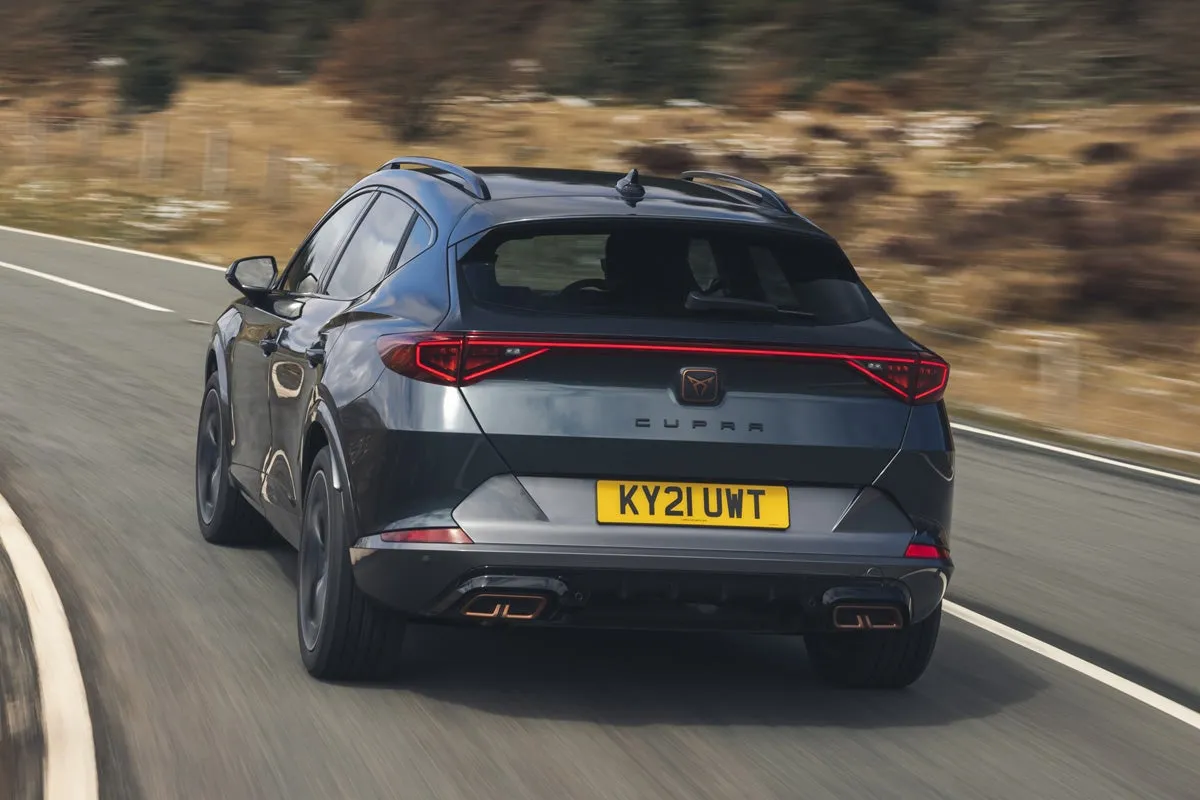
Even if the Cupra Formentor's crossover body means it'll never feel as agile as a low-slung hatchback, it can provide comical slides if you let the front tyres load up and take your foot off the gas. Sounds crazy, but it's true. Perhaps this is why turning the stability control off is followed by the message: 'are you sure?'.
With its larger wheels, bigger tyres and four-wheel drive, the 310PS model - later upped to 333PS - is in some respects better behaved than the less sporty versions. Its four-wheel drive means wheelspin is pretty much nonexistent no matter how much you try and provoke it, and it feels really nailed down in bends.
Despite being fun, the Formentor also proves itself to be comfortable: taught, but not overly bouncy over bumps and surface changes. The standard setup serves up a decent halfway house, while VZ models get Dynamic Chassis Control, so you can set the suspension to be firm for sharp cornering or softer for added comfort on a long journey.
At a cruise, the Formentor performs well on the motorway. Active cruise control is fitted as standard so the car will follow others at a safe distance and its lane assist does a good job of keeping the car in lane (useful given how distracting the infotainment can be).
The infotainment wins back points because it can find you a parking space, and the Cupra Formentor is an easy car to drive in town. It's raised suspension give you a decent view out the front – and means you can breeze over speed humps – and although the back window seems quite far away, even the basic model has rear parking sensors, while every other model gets a camera and park assist as well.
The park assist can slot the Formentor into parallel and perpendicular parking spaces, steering you in as you operate the accelerator. If you prefer to do your own parking, DSG automatic cars creep – rather than jerking into motion – for fewer heart-in-mouth moments when you're manoeuvring.
Hybrid models serve up their own driving experience. Their ability to accelerate up to a cruise on electric power makes them very relaxing, but the payoff is slightly heavier steering and blunted handling due to the extra weight they carry. You'll only notice this if you're really pushing on, though.
What engines and gearboxes are available in the Cupra Formentor?
When it first went on sale, the Cupra Formentor was available with a variety of turbocharged four-cylinder petrol engines: a 150PS 1.5-litre, a 2.0-litre with 190PS or 245 PS, two plug-in hybrids with a 1.4-litre petrol and an electric motor that combine to give outputs of either 204PS or 245PS, and a range-topping 2.0-litre model producing 310PS.
The least powerful engine gets a six-speed manual gearbox as standard, although the seven-speed dual-clutch automatic is optional. It's standard-fit on the rest of the petrol range and serves up slick and smooth changes whether you're cruising along or driving more energetically.
Whether you choose the optional automatic or not, the 150PS model is a fine entry-level car. Its engine is smooth and quiet and serves up decent performance of 0-62mph in 8.9 seconds whether you choose the auto' or stick with the manual. A top speed of up to 127mph means cruising is relaxed: in fact, you'll struggle to pin-point engine noise at the legal limit.
The 190 4Drive and 245PS models serve up incremental performance gains: they get from 0-62mph in 7.1 and 6.8 seconds, respectively. The 190PS model has four-wheel drive, which gives you plenty of traction in slippery conditions, but both versions have useful overtaking power if you do lots of driving on country roads.
The 310PS model is the quickest car of the lot by some margin. It gets from 0-62mph in 4.9 seconds – less than a second off a Porsche 911's figure – and quicker than the Cupra Leon hot hatch (5.7 seconds). That said, much of this is down to the four-wheel system that launches it from a standstill like it's been hooked up to an aircraft carrier's catapult. Even so, it still seems to lack the Cupra Leon's explosive mid-range fizz: perhaps that's because the Formentor tips the scales at 1644kg compared to the Leon's 1490kg.
Weight's not something the hybrid models will be keen to talk about. They're the lardiest of the lot at 1681kg (204PS model) and 1704kg (245PS), yet they post decent respective figures of 0-62mph in 7.8 seconds, and seven seconds dead.
Acceleration can be frustrating in practice, though. Push your foot flat on the throttle and it's as if the car is running through a pilot-style checklist before serving up the forward motion you've asked for: ignite engine? Check. Engage drive? Check. Drop down a few gears? Check. Increase engine revs? Check. And, what seems like a long second later – you're away.
If you can live with this, there's not a lot else to complain about. Unlike PHEVs of old, it's easy to chunter about on electricity without ever engaging the engine: even accelerating from a standstill to 60mph won't produce the slightest whiff of an exhaust fume, making it a relaxing car to travel in.
In 2024, a facelift to the Formentor saw the introduction of some new powertrain options: a new version of the 1.5 TSI petrol engine with a six-speed manual gearbox, and a mild-hybrid version called the eTSI, which comes with a DSG automatic transmission. Both have 150PS. A new version of the plug-in hybrid e-Hybrid tech was also introduced. In V1, V2 and V3 trims it has 204PS and an electric-only range of more than 70 miles. In the performance-focused VZ trims, power is upped to 272PS.
The VZ range also has a new, more powerful range-topping petrol engine, with 333PS powering all four wheels. Predictably, it feels exceptionally quick. Another petrol option, a 265PS 2.0-litre model, arrived later in 2024, but we still haven't had the chance to try it yet.
Refinement and noise levels
The Cupra Formentor's large wheels (no less than 18-inches in size) drum up quite a lot of road noise, which is amplified by the car's relatively sporty suspension setup. A more comfort-orientated SUV – a Skoda Karoq on 17-inch wheels, say – would be quieter in this respect.
There's not a lot else to complain about, though. Engine noise is well muted in the petrol models (and non existent when the e-Hybrids are running on electricity), while there's very little wind noise and no squeaks or rattles.
Safety equipment: How safe is the Cupra Formentor?
The Cupra Formentor was given the full five-star rating for safety when it was crash tested by Euro NCAP in 2021, so you can expect it to stand up well in an accident.
All models get adaptive cruise control that can accelerate and brake the car for you, along with lane assist that keeps the car on your side of the road using the steering rather than by dabbing the brakes like lesser systems.
To that lot you can add road-sign recognition, which displays signs on the infotainment screen – handy for those tricky 20mph in-town limits – and high-beam assist, which dips your full-beams when another car is detected.
VZ2 models and above get the Driving Pack XL. It adds a blind spot warning system that detects cars in your blind spot, lane change assist – if it is safe to do so, the car pulls out automatically when you indicate to overtake – and emergency assist, which means the car can steer around collisions in an emergency. You also get exit assist, which will warn you if you try to open your door in the path of a cyclist.
MPG and fuel costs: What does a Cupra Formentor cost to run?
"The Cupra Formentor's broad range of engines means you can choose one – weighing fuel economy against performance – that won't suck your wallet dry of its contents. The basic petrol's moderate thirst means most people won't miss the lack of a diesel option."
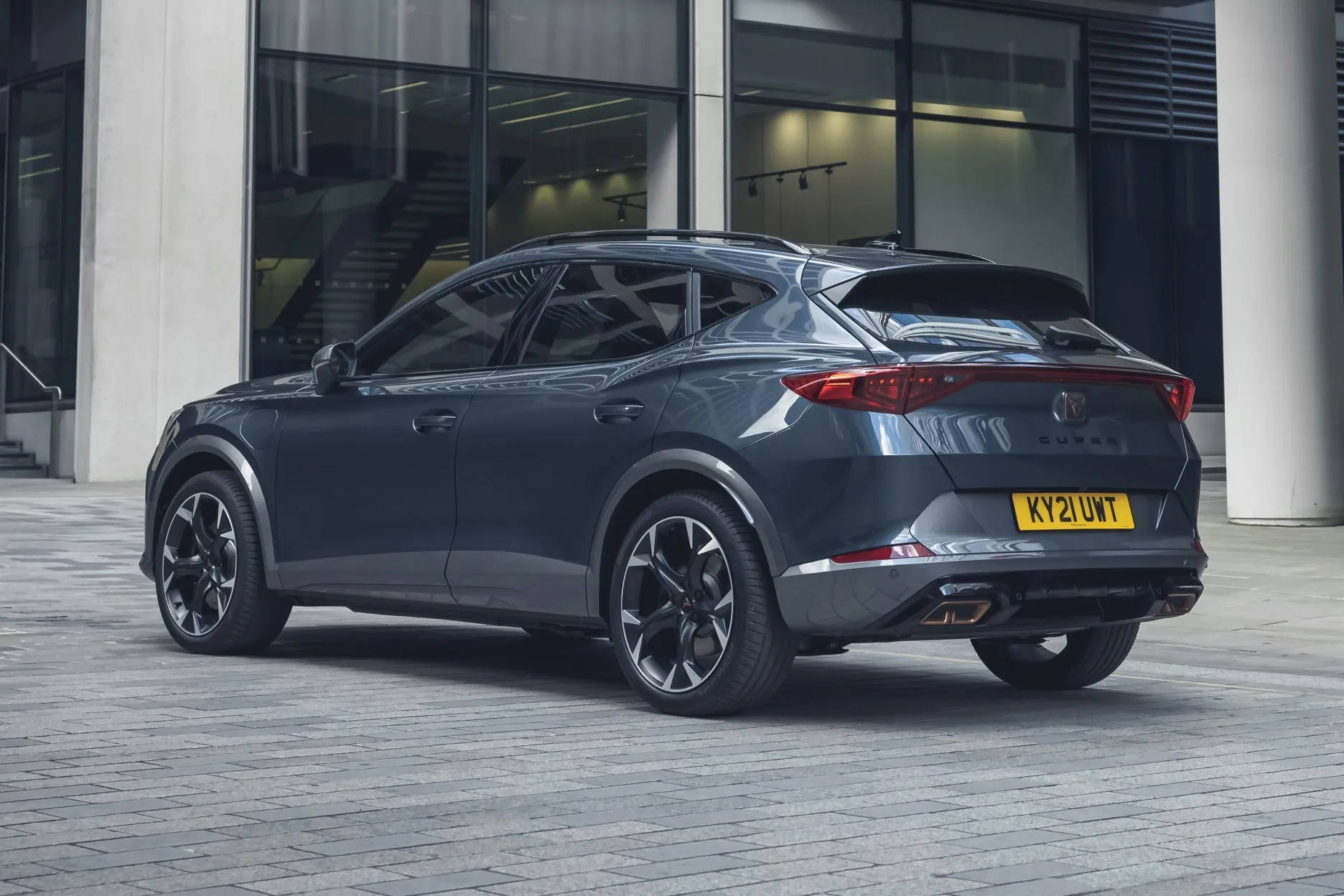
The 150PS automatic model we've spent the most time in serves up reasonable performance yet it'll return fuel economy of 42mpg officially, and we got 38mpg while paying no attention to driving frugally. Even a pacy run couldn't get that figure to drop below 35mpg. Armed with this knowledge, it's reasonable to assume that most of the rest of the range will be capable of returning official figures in the real-world driving.
The manual 150PS will be a tad more economical than the auto, returning up to 44mpg. Want a significant jump in power and the reassurance of four-wheel drive from your used Formentor? You'll want the 190PS 4Drive or 245PS models, and they see fuel economy drop to a perfectly respectable 37.7mpg or 36.7mpg, respectively.
Fancy a more significant hike in power? Then try the blistering 310PS version on for size. Its fuel economy drops to 33mpg: not great, but not that bad, either, when you consider the performance on offer.
That leaves the 204 and 245PS e-Hybrids, which we'll call the have-your-cake-and-eat-it models. They're quick, but because they can run on electricity alone for up to 34 miles, post figures of up to 235mpg. That's a misleading figure in some respects. Perhaps a better way to look at it is that if you have a short commute and somewhere to charge the car, you'll be able to get to work and back without ever burning expensive petrol.
The 2024 facelift brought with it new power options and increased efficiency. With the V models, the 150PS petrol model now promises up to 46.3mpg according to official figures, while the mild-hybrid version returns up to 47.9mpg. The 204PS plug-in hybrid model's MPG figure is claimed at upwards of 700mpg, thanks largely to an improved electric-only range of more than 70 miles, but again, be sceptical of those figures because what you'll actually get heavily depends on how much you use the battery rather than the engine.
In the VZ cars, the 272PS plug-in hybrid also promises more than 700mpg (but with the above caveat), while the 333PS petrol engine promises up to 32.5mpg. The 265PS version of the 2.0-litre petrol does slightly better with up to 36.2mpg.
Cupra Formentor reliability and warranty
In the latest 2025 edition of the HonestJohn.co.uk Satisfaction Index, Cupra placed in 13th position for reliability, out of 33 carmakers considered. So, despite being a relatively new brand, it's already ahead of the industry average. The Formentor itself didn't feature in the list of the 20 most reliable models in the study, but it didn't feature in the bottom 20, either. Also bear in mind that Cupra offers the most generous warranty of any VW Group brand at five years, 90,000 miles.
Cupra Formentor insurance groups and costs
Cupra Formentor insurance groups range from Group 19 (150PS V1) to Group 35 for any model fitted with the 333PS engine.
VED car tax: What is the annual road tax on a Cupra Formentor?
Since April 2025, when the exchequer withdrew VED discounts for hybrids and exemption for EVs, all passenger cars made after 2017 are liable for the same flat rate of road tax regardless of the fule they use, and this flat rate is currently charged at £195 per year.
That's not the full story, though. Any car that costs more than £40,000 (inclusive of optional extras) when brand new is subject to an additional 'luxury car' surcharge of £425 per year for a five-year period, between years two and six of the car's life. The prices of most higher-end versions bust that threshold, and even many of those that don't get pretty close. If the car you're considering has a few optional goodies fitted, that could well take it over, lumbering you with the extra burden. It's always worth doing an online check on the reg of any potential purchase to make sure you know what you're looking at.
Cupra Formentor price
"The Cupra Formentor hit showrooms in the spring of 2021 with new prices ranging from £30,000 for a 150PS V1 model to £46,000 for a 310PS VZ3 car. These days, prices start at around £34,000 and rise to upwards of £54,000 for the range-topper. That's inflation for you."
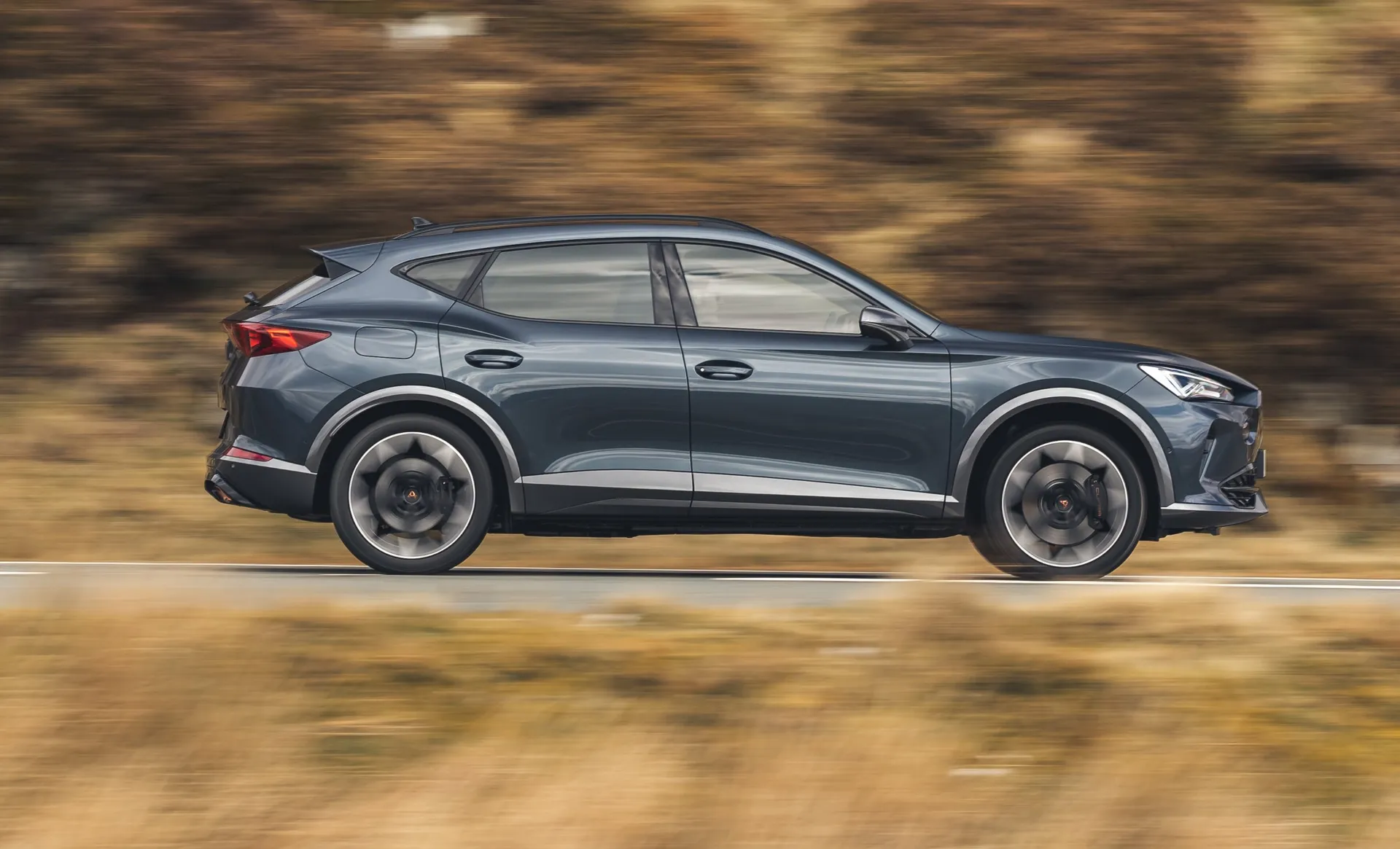
Thankfully, the Formentor's popularity means there are plenty of models available on the used market, where you can save an absolute packet. Browse our listings, and you'll find the cheapest ones clocking in at around 17 or 18 grand.
These will have the entry-level 1.5-litre engine, or the lower-powered plug-in hybrid powertrain, be in lower-end V1 or V2 trims, and will have done somewhere in the region of 60,000 miles. If you want one of the 300-horsepower-plus models, you'll be looking at a minimum of £23,000, with a similar mileage. Even so, that's quite a saving.
Trim levels and standard equipment
The Cupra Formentor was originally available in five trim levels – V1, V2, VZ1, VZ2 and VZ3. A sixth option, the V3, was introduced with the 2024 facelift, as was a special VZ First Edition model.
In isolation, it would be easy confuse the basic Cupra Formentor V1 as a top-of-the-range model. It looks great thanks to its body kit, roof bars, 18-inch alloy wheels and all-round LED lights.
There's plenty of kit to talk about, too. You get automatic headlights, auto wipers, rear parking sensors, tri-zone climate control and keyless entry. Infotainment is also comprehensive with the car getting a digital instrument binnacle and a large 12.0-inch infotainment screen (12.9-inches on facelifted models) that has connected navigation as well as Apple CarPlay and Android Auto: wireless in post-facelift cars, which also get a wireless phone charger.
All that all being said, Cupra Formentor V2 models are noticeably nicer. On the outside they get prettier 19-inch alloy wheels, whilst inside you'll find a real Nappa leather interior, or Dinamica synthetic suede on post-facelift models. The seats are also electrically adjustable (with a memory function) and, like the steering wheel on pre-facelift cars, they're heated. V2s are also easier to park, adding front sensors and a rearview camera to the mix. Post-facelift cars have front sensors as standard on all models, and come with an electric bootlid on V2 models as well as keyless entry and start.
The Cupra Formentor V3, available from mid-2024 onwards, adds a different design of 19-inch wheel finished in black and copper, and further upgraded, electrically adjustable front seats with a memory function. The seats are upholstered in leather and there's a top-view camera system to help with manoeuvring. Extra safety systems are added, too, including a blind-spot monitor.
Cupra Formentor VZ1 models are sportier. Using V1 as a base, they add 19-inch wheels and a diffuser-look rear bumper, plus you get Dynamic Chassis Control, so you can adjust the suspension to be comfy or firmer for more control. Inside, you get manually adjustable bucket seats (electrically adjustable and heated in post-facelift cars) and a boot that opens when you waggle your foot under the rear bumper (but not in post-facelift cars). Safety kit is boosted with auto-dipping headlights, traffic-sign recognition and a system that can warn you not to open your door into the path of other cyclists.
Cupra Formentor VZ2 adds to VZ1 with a Nappa leather interior, electrically adjustable seats that are heated, and you also get a heated steering wheel in pre-facelift cars. Pre-facelift VZ3 models, meanwhile, are reserved for the 310PS model, adding 19-inch wheels with copper highlights and uprated Brembo brakes. Post-facelift VZ3s are available with the 272PS plug-in hybrid powertrain as well as the 333PS four-wheel-drive petrol model, and the 265PS petrol. These feature a Sennheiser sound system and carbonfibre-backed bucket seats. The uprated brakes are made by Brembo on plug-in models, and Akebono on the petrol models.
Ask the heycar experts: common questions
Who makes Cupra Formentor?
What kind of car is a Cupra Formentor?
Is the Cupra Formentor a hybrid?
Get our latest advice, news and offers
Keep me updated by email with the latest advice, news and offers from heycar.
By submitting you agree to our privacy policy
